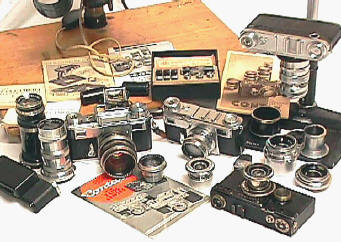
Home Camera Articles FOR SALE Orders I Buy / Wants Repairs Books Adapters

Contax II and III
Zeiss' Successful Leica Competitor
After being embarrassed with the failures of their Contax I, Zeiss circled the wagons and came up with a winner. 1936-1942
A good argument can be made the Contax III was the world's first modern 35mm camera, as it was the first 35mm system with a built in camera exposure meter. Yes, I know about the earlier 35mm Contax TLR camera, but its outlandishly poor design disqualifies it from the "modern" category.
"Superlatives are too frequently abused. We will content ourselves by saying that Contax II represents the most advanced miniature camera design and construction of the present day." 1936 Zeiss Catalog
Contax II mounting a Voigtlander Prominent 50/1.5 Nokton INFO HERE
After photography conglomerate Zeiss fell on its royal laurels with the incredibly unreliable Contax I shutter, it went back to the drawing boards and introduced the Contax II and II in 1936. With the Contax II and III, Zeiss not only had a legitimate competitor to Leica, in many ways it bettered Leica and was often considered THE Professional 35 system. It was a success Zeiss would not enjoy after W.W.II. combating the likes of the formidable Leica M3. Today most Contax II / III are well worn, they were workhorses. Zeiss had the goal of making it the best made 35mm camera, and many longtime Contax users consider the heavy duty and complicated construction the high point of Contax Rangefinders. Leica won the rangefinder race in the long run, with used Contax prices taking a fall. Contax bodies and lenses sell generally sell for much less than their contemporary Leicas.
In use the Contax II and III proved to be very reliable cameras -- just as reliable as their contemporary Leicas in my opinion. While the Contax occasionally needs shutter curtain straps replaced, the Leica occasionally needs shutter curtains replaced. Both need occasional cleaning, lubrication, and adjustment to keep working. Both pre-war lens systems have the tendency to fog up over the years and will require a professional cleaning if you want the best results.
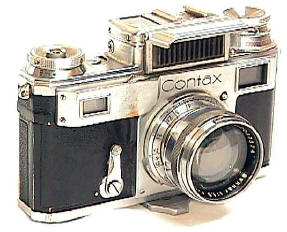
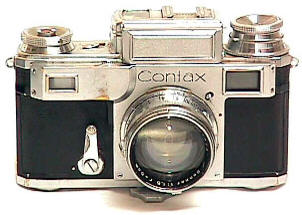
The Contax III with 50/1.5 Sonnar. The III was the first professional quality 35 with a built in meter. Yes, I know about the earlier Contax TLR, but it was just a bad design idea and not worthy of professional consideration. The Contax II / III self timer was probably the first on a system 35.
In 1936 the new Contax beat Leica in a number of significant areas:
A much longer rangefinder for more accurate focusing. Instead of a moving mirror system that Leica used, and still uses, Zeiss used a more expensive system which Zeiss claimed was more accurate system. By rotating two glass wedges to achieve rangefinder focus, rather than a single mirror, Zeiss claimed higher rangefinder accuracy which would practically never go out of alignment. Rangefinder baselength was a gargantuan 90mm with a magnification of about .75, giving an effective baselength of an amazing 67.5 -- 8% longer than the Leica M3 and 15% more accurate than its contemporary Leica screw mount competitors.
A combined viewfinder and rangefinder, rather than separate RF and VF ports. Again, Leica would not match this feature until the M3 almost 20 years later. It was a major advance. Neither Contax or Leica offered parallax correction or bright line frames like the later Leica M series.
A single non rotating shutter dial, instead of the Leica IIIa's separate slow and high speed dials. Contax combined the shutter speed dial with the advance knob, enabling the photog to change speeds before or after the camera had been wound. This sounds pretty tame today, but in 1936 it was a major technological advance. Leica would not be able to claim the same until the M3 almost 20 years later.
A metal vertical traveling shutter, impervious to the sun's rays burning a hole in the shutter. The shutter was very complicated, varying BOTH the size of the slit and the travel of the curtains to adjust speeds. About 700 parts, far more than the Leica, went into the Contax II / III. The brass slats ran on straps. 60 years after the cameras left the factory, its not unusual to find them with inoperative shutters due to broken straps. On the other hand, you have to wonder how many times the cloth curtains have been replaced in that working pre-war Leica.
A top speed of 1/1250 instead of the Leica IIIa's 1/1000. In truth this was more of an advertising claim than a significantly faster shutter than the Leica. Shutter speed sequence is B, 2, 5, 10, 25, 50, 125, 250, 500, 1250. The postwar IIa / IIIa added T and 1. One Second Plus could be approximate by using the self timer on B.
Much easier loading with its removable back and easy access. Even with the Contax double locks, it was MUCH easier and faster to load and unload the camera.
Bayonet mount lenses instead of screw mount lenses for faster lens changing -- at least according to Zeiss. Real world, they were about the same in the speed changing department.
Self Timer: all II / III had self timers. Only a few pre-war Leicas left the factory with a self timer.
The Contax III had 35's first built in meter on a rangefinder
A wider lens lineup from 28 to 500 mm Vs 28 to 400mm in 1936
Faster wide angle lenses with the 35/2.8 Biogon and 42.5/2 Biotar. Leica's fastest wide was 3.5
Sharper super speed lenses: the Contax 50/1.5 Sonnar and 50/2 Sonnar were generally thought to be sharper than Leitz 50/1.5 Xenon and 50/2 Summar
Fastest 85 and longer lens, the sharp 85/2 Sonnar
Longest rangefinder coupled lens, the 180/6.3 Tele-Sonnar
Fastest longer than 135 lens, the magnificent 180/2.8 Sonnar. Leitz fastest longer than 135 was the 200/4.5 Telyt.
Generally Zeiss photogs talked about their lens' sharpness, while Leica photogs swooned about the hard to define "Leica Look" of their optics. It's true Horatio, there is more in heaven and earth than is dreamt of in your lens tests.
An interchangeable ground glass back for separate glass plate exposures, the Leica fixed back design could offer no such accessory.
Strangely enough, the Contax was lower priced than Leica.
An extensive system of accessories that matched Leica's -- quite an achievement considering Leica's six year head start in 35mm and Leica's astounding sales.
Like the pre-war Leicas, the Contax II and III did NOT have TTL metering, factory flash sync, large built in viewfinders, or parallax correction.
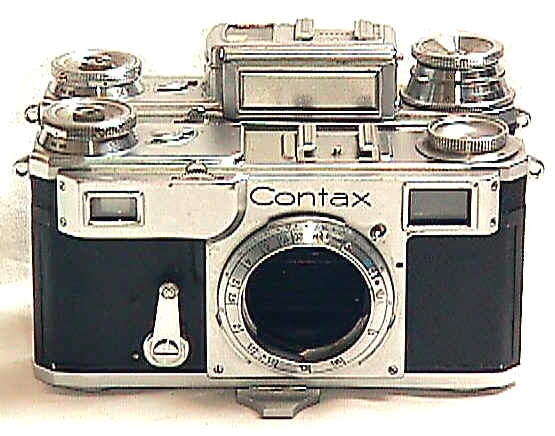
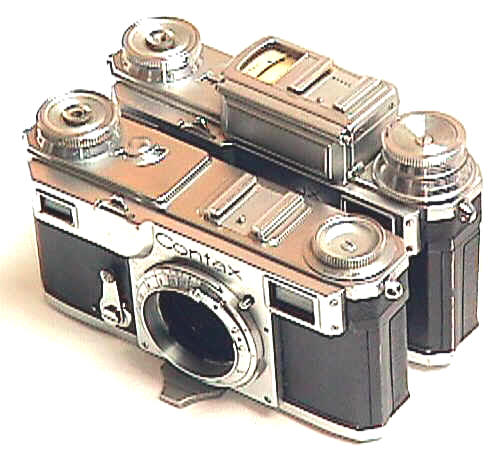
With its built in meter and combination rewind knob/exposure calculator, the Contax III was noticeably larger than the Contax II. Shooters today usually prefer the II due to the III's larger size and relatively useless by modern standards exposure meter. Yet by 1936 eyes, the III's built in meter was a technological tour-de-force, a very modern feature. I wonder how today's F5 and EOS1N will be viewed in 60 years as new photogs ask: "Photographers really used long rolls of flexible animal based backing for latent image storage as late as the 1990's?"
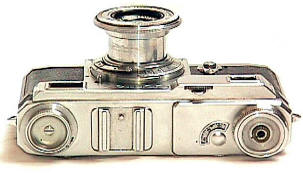
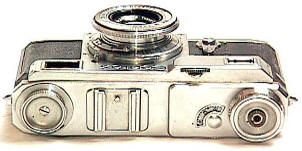
The advantage of collapsible lenses was considerable space savings and easier carrying -- too bad this concept is seldom used by today's camera designers.
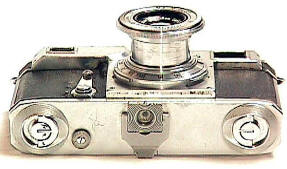
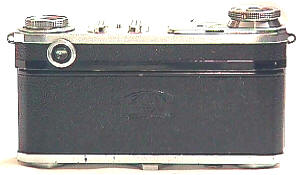
The double lock back is cumbersome, but a welcomed relief if you have ever spent 10 minutes trying to load a screw mount Leica. Note the hinged "foot" around the tripod socket which would steady the camera and keep it from falling forward. Apparently Zeiss did not consider a camera resting on its nose very dignified for a Zeiss product. Also notice the modern style push button rewind button on the baseplate. . No production model Leica or Contax left the factory with flash sync until after the war.
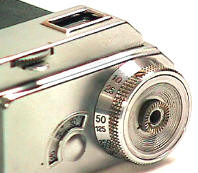
The Contax rangefinder base was so wide the photog could easy cover one rangefinder port with their right hand if not careful. The large advance knob was a bit quicker than Leica's in my experience, but changing the shutter speeds is a bit slower. Like Leica, the film counter had to be manually set at the beginning of the roll. For reasons I have never understood, probably just to be different from Leica, Contax normals and wides could be focused by the right index finger with the small focusing wheel shown here near the rangefinder port. To me at least, just turning the helical with your left hand is faster and easier.
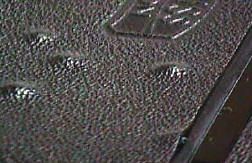
While the Contax II and III were well finished, frankly I find their chrome and their leather body covering distinctly a notch below their contemporary Leica's very high level. While Zeiss used quality morocco leather, it simply did not age as well over the years as Leica's harder and nearly impervious vulcanite body covering. Likewise Contax chrome seems to be thinner than Leica's. Leicas hardly ever brass through the chrome, but it is not that unusual on Contax II and III's. Zeiss corrected this problem with a much higher quality chrome on the post war Contax IIa / IIIa. Shown here are what many Zeiss collectors call "Zeiss Bumps." These can inflict just about any pre-war Zeiss metal framed camera. I'm told they are the result of a chemical reaction between the leather and brass. Unfortunately the problem is rather common. I doubt, however, that Zeiss patented the bump process as some Zeiss collectors speculate.
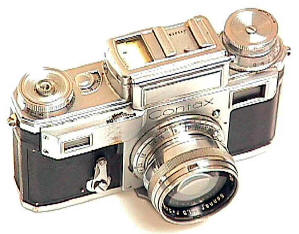
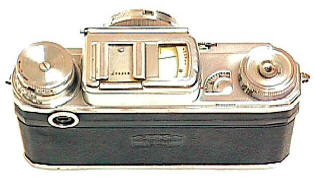
The III's meter readout window atop the meter is shown here.
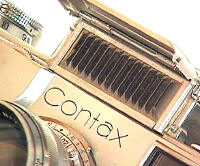
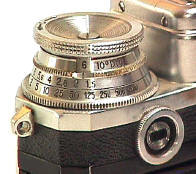
For use the selenium meter cover flipped up, which also helped to shield the meter from erroneous sky readings. Meter coverage roughly equaled the 50mm field of view. The rewind knob was combined with an exposure calculator. Dialing in the meter's top deck reading would give you exposure choices, which then had to be transferred to the lens and shutter. For 1936, this was cutting edge technology.
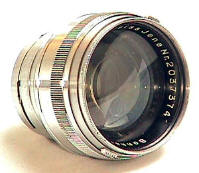
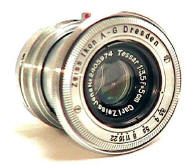
The Zeiss super speed 50/1.5 alongside the 50/3.5 collapsible Tessar. The Sonnar 1.5 was generally considered much superior to Leica's Schneider designed 50/1.5 Xenon. Even by today's standards, the 50/1.5 Sonnar is a fine performer. The Tessar's performance was comparable to Leica's famous 50/3.5 Elmar, though the Tessar's aperture ring was much easier to change.
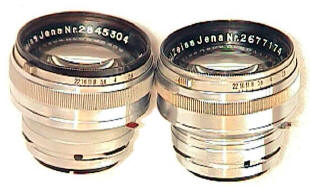
Zeiss patented lens coating in the 1935. Zeiss started coating the 50/1.5 Contax lenses before the war. Lens coating revolutionized lens making, and its importance and Zeiss leadership in optics at that time can hardly be overestimated. Leica did not coat production lenses until after the war. I have four 50/1.5 Sonnars, all different. # 2037374 (1937) is uncoated. # 2393454 (1938) is coated, but not marked with the red T to indicate coating. # 2677174 (1940) is coated and marked with the Red T. # 2845304 (1942) is marked with the red T, but also has a black front rim what appears to be an alloy (not chrome) rear lens mount.
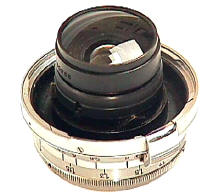
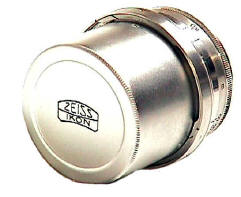
The Contax 35/2.8 Zeiss Biogon is generally considered by far the best pre-war 35 mm wide angle optic. This is even more of an accomplishment considering that the Biogon was also the fastest pre-war 35mm focal length lens. Note the deeply recessed rear element and the now hard to find chrome rear cap. This pre-war design lived on after the war as a Russian made 35/2.8 for their Kiev. Neither would mount on the post war Contax IIa or IIIa.
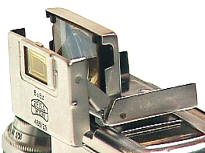
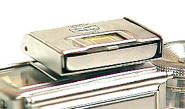
Zeiss made a whole series of Contax folding Albada finders. Black finders are for the Contax I, chrome for the Contax II. I am not sure how Zeiss Albadas performed when new, but 50 years later they almost always have badly degraded image quality -- putting them in the useless user category. This finder is for the 50 and 85.
Unlike Leica, Contax had an optional single exposure plate film back for either the Contax I or II / III. It also allowed for ground glass focusing. Today this seems a bit odd, but in the 1930's when many laboratories and scientific work used glass plates, this was an important and very useful feature.
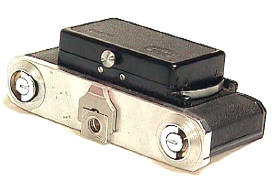
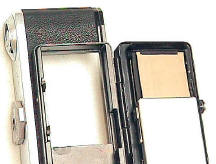
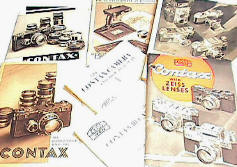
As would be expected, Zeiss offered extensive Contax original literature, brochures, and price lists, though unfortunately today it is much harder to finder than Leica literature. Here the discontinued Contax I is shown alongside the newer Contax II and III, apparently Zeiss had a hard time getting rid of the darn things.
Zeiss Trivia: A friend who visited Zeiss before the war explained that both Zeiss and Leica had three year photography training programs at their respective factories. Even more remarkable was the Zeiss glass works in Jena. It turns out the entire glass works was built on a barge in the middle of a lake to reduce vibration during glass pouring to reduce glass bubbles. Every day workers would hurry to work, BEFORE the draw bridge went up in the morning. Once up, the draw bridge did not come down again until the end of the work day.
A few Wartime German Navy Kriegsmarine Contax have surfaced -- damn I like puns. I've been told they were standard U-boat issue, but have not been able to confirm the story. So far as is known, ALL Contax II and III left the factory with chrome finishes. Leica started 35mm photography with black cameras, and introduced their chrome finish in 1933. Consumers seemed to prefer it at the time, thinking of chrome as a more expensive and durable finish. Zeiss strategy of making only chrome Contax II's and III's seems to be a marketing ploy of higher perceived quality. Zeiss complemented their new camera with a new series of chrome lenses. Though Leica switched to a grey paint finish during the war to save chromium, strangely enough the more heavily chromed Contax did not.
After the War, the Russians found themselves in possession of the Zeiss factory, complete with the dies for the Contax II and III. Later the dies were moved to the heart of mother Russia. The Contax II was reborn as various Russian "Kiev." Lenses ran the range from 28 to 135 and were fully compatible with the Zeiss Contax II / III. The last Kiev 5 was a new and interesting design, complete with large brightline finder and nifty folding rewind lever. Unfortunately, all examples I have seen show mediocre workmanship compared to the Contax. Occasionally black or green/tan military style "Contax" show up, sometimes complete with Luftwaffen engravings. Don't be fooled, they are recent Russian Kiev conversions for the sake of the capitalist dollar.
When was your Contax II or III made ?? According to the excellent "benchmarks" book by Foto Saga in France, ISBN 2-906840-06-8, the first letter before the serial number denotes a block of 99,999 serial numbers -- not all of which were always issued: Z 1935/6, A 1936, B 1936, C 1936/7, D 1937, E 1937, F 1937/8, G 1938, J 1938/9, K 1939, L 1939, M 1940/42, N 1941/3. Keep in mind the code was also used for other Zeiss cameras, so these codes do not indicate total Contax production.
Contax Contameter for Close-ups
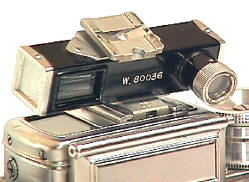
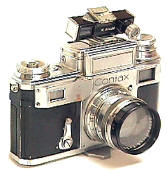
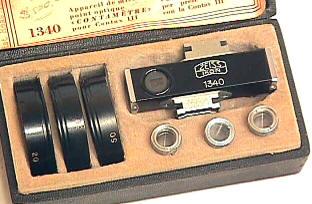
Contax had a rather nifty system for close-ups, the Contameter. You attached the proper close-up lens to the camera lens, matched it with the proper close-up lens for the Contameter viewfinder which attached to the top of your camera. Focusing was then parallax corrected for the fixed distance of that particular combination, either 20, 12, or 8" which translated to reproduction rations of 1:10, 1:6.5 and 1:4. You focused by moving the camera in/out until the rangefinder image was focused in Contameter viewfinder. In practice, it's a quick and easy to use system.
Contax Reproduction Stand
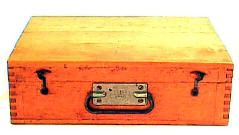
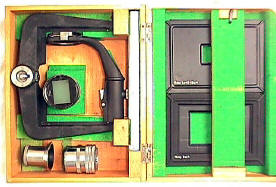
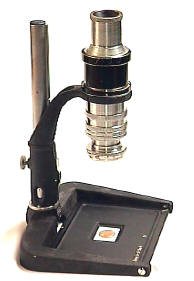
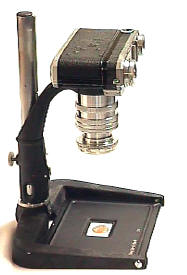
This system used pre-set reproduction ratios with its various adapter rings for 1:4, 1:3, 1:2, and 1:1.5. with a 50mm lens. While offering ground glass viewing, focusing was not really necessary -- just attention to use the right adapters with the right baseplate. The base plates shows the exact field which would be in picture. After the war, Leica marketed a very similar device. Today these are very hard to find, especially complete.
Before W.W.II, Leica and Contax were the only two widely available system 35's, as Exakta was newer and had a much smaller market share. Each had advantages and disadvantage, yet the Contax was generally considered the professional's choice as it had a wider lens line up of faster and sharper lenses. The photographer's choice said as much about their personality as it did about their photography.
------------------------------------------
Long story short, after WWII the tools and dies of the Zeiss Contax were carted off to Russia as War Reparation, resulting in the long lived Kiev camera.
Voigtlander Nikon/Contax Rangefinder Related Products
Voigtlander Bessa R2S R2C Rangefinders in Classic Nikon or Contax Rangefinder Mounts
Voigtlander Bessa R2S 50mm f/3.5 Heliar S NHS Commemorative in Classic Nikon Rangefinder Mount
Voigtlander SL 12/5.6 and 15/4.5 Aspherical widest EVER for NRF
Voigtlander Nikon Rangefinder SC Mount Lens Intro 21/4, 25/4, 35f/2.5 intro
Voigtlander Nikon Rangefinder SC Lenses: SC 21/4, SC 25/4, SC 28/3.5, SC 35f/2.5, SC 35/1.2 Prototype, S 50mm f/1.5, S 50f/2.5, S 50mm f/3.5, S 85mm/3.5
Voigtlander VC Meter II small compact silicon meter with LED readout for Nikon Rangefinders
CameraQuest Home Shopping Cart Price List Camera Articles I Buy / Wants Repairs Books Adapters
Revised: September 13, 2017 . Copyright � 1998-2002 Stephen Gandy. All rights reserved. This means you may NOT copy and re-use the text or the pictures in ANY other internet or printed publication of ANY kind. Information in this document is subject to change without notice. Other products and companies referred to herein are trademarks or registered trademarks of their respective companies or mark holders.